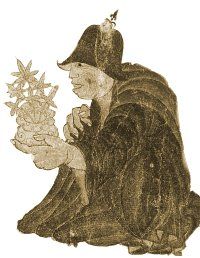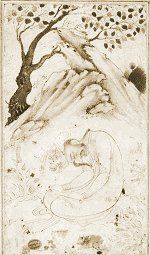Serving the Guest: A Sufi Cookbook
Essays | Recipes | Gallery

"The traditional version of this recipe comes from a saki-khaneh in Quetta, Baluchistan, Pakistan. This technique requires three people and much patience.
"Take about a half a pound of cannabis, either the shade-leaves from cultivated hashish-plants, or if using very weak quality include the buds as well. Strip away the branches but do not separate the leaves and seeds.
"Heat the leaves and seeds on a dry griddle over a low-medium flame till the leaves are crisp and an oily smell begins to arise.
"Now wash the greenery in cold water a few times, gently but thoroughly, and squeeze it gently. I was told that the omission of this step causes headaches, but have no empirical proof of that assertion.
"Now take a fired clay pot, capacity at least several gallons. The bottom-inside must be rounded, not flat — and it must have been scored before firing with a crisscross pattern of slightly raised edges or welts.
"Place the wet cannabis in the bottom of the pot. At least one person has to hold the pot steady while one other person wields a pestle, a piece of wood about two and a half feet long which can be easily grasped, and with a blunt club-like end. Rotate and grind the bhang with the pestle, using both hands. Get up a good steady stirring rhythm, like paddling in a canoe race. Chant some appropriate folksong. Keep it up for at least two hours.
"The following are favorite flavor-additions, to be crushed with the bhang according to taste: almonds, pistachios, cardamoms, peppercorns (white and black), cinnamon stick and any sort of edible seed such as white or black poppy, sunflower, etc.
"When the bhang is thoroughly creamed to a superfine paste, scrape it from the pot and put it in a cotton cloth or folded cheesecloth. Hold the edges of the cloth over a pail or bucket (this needs two people) and begin to pour a slow trickle of cold water overt the bhang while gently kneading the lump of paste with your fingers. Keep kneading and pouring till the water which dribbles into the bucket is not longer green-tinted. Discard the remaining paste and drink the bucket of liquid — about twenty to forty servings.
"In Benares bhang is prepared on a flat rubbing-stone mortar and pestle and sold in small pellets. The poor swallow these pills with water, but the well-to-do dissolve them in milk or lassi with flavored syrups (rose, almond, khas) or sugar and spices.
"In the modern technique the hours of grinding and singing may be eliminated by the use of a Cuisinart, Osterizer or other high-speed blender, for about a half an hour. Use Domestic Backlot, or the shade-leaves from sinsemilla, since anything else would be expensive and wasteful — and too powerful."
from Serving the Guest: A Sufi Cookbook
Copyright © 1999, 2000 by Kathleen Seidel
Sources of previously published material by other authors used by permission, and print sources for images, may be found at http://www.superluminal.com/cookbook.
